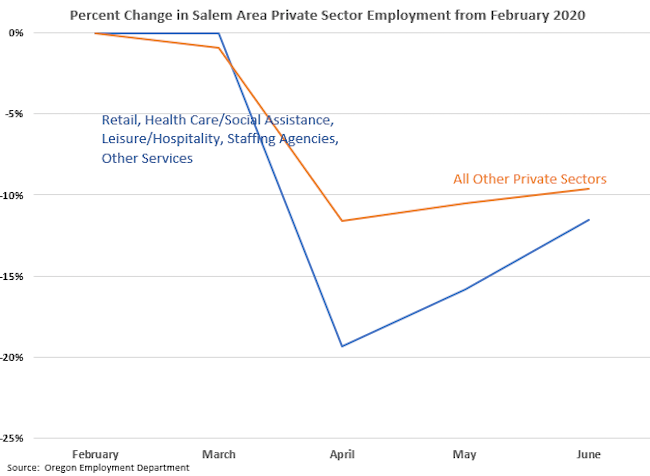 A graph showing the percent change in the Salem area’s private sector employment from Februay 2020. (Source: Oregon Employment Department)
A graph showing the percent change in the Salem area’s private sector employment from Februay 2020. (Source: Oregon Employment Department)
The pandemic-related shutdown of the economy will go into the record books with a lot of “firsts” and we’ve just seen another one. The unemployment rate in the Salem area came down by three percentage points in one month, from May to June. In the last recession, the unemployment rate took three years to come down three points.
The unemployment rate is down because the Salem area recovered another 3,500 private sector jobs in June. More than 16,000 people are still unemployed, however. And unemployment is most severe in the lower-paid service industry jobs of the economy (see graph).
Researchers at the federal labor statistics agency have added detail to the story of how the shutdown is affecting low-wage workers in service industries. Using information from the monthly survey that produces the unemployment rate, researchers found that the characteristics of the service industry unemployed are different from those in other industries.
Let’s look at the national study results and then see how they might be affecting the Salem area.
More Latinos and other minorities work in these industries, more workers are aged 25 or younger, work part-time, have lower levels of education, and are single parents, than in other industries in the economy.
The study findings for part-time workers and single parents are worth describing in detail. More workers in these industries work part-time than in other industries – for example, nearly 30 percent of retail workers are part-time. Many of these workers live with other family members and contribute to family income. Additionally, one in five single-parent job holders earn all their income from a low-paying service industry job, according to the national study.
What are the characteristics of Salem area workers in service industries?
Nearly one in four Salem area residents is Latino, and Latino workers are a significant portion of the workforce in the service industries most affected by the shutdown. According to the Census:
· 20 percent of the Salem area Retail workforce is Latino;
· 15 percent of Health Care and Social Assistance;
· 22 percent of Leisure and Hospitality;
· 20 percent of Staffing Agencies; and
· 13 percent of Other Services (hairdressers, shoe repair, auto techs, etc.).
In addition, approximately one in three Latinos in Salem speak English not well or not at all, according to the Census.
Other characteristics of Salem area service industry workers are as follows:
· They are young; 16 percent of them are younger than 25 – this contrasts with only eight percent of all other industry workers;
· 44 percent of Salem’s workforce works part-time, and many of these work in service industries;
· The percentage of Salem area residents with less than high school, and high school only, is higher than the state average; and
· Some are single parents – there are 9,000 single parent families in the Salem area, and many work in service industry employment.
In past recessions, job seekers who were young, who had less education and skills, were single parents, or had limited English language abilities, had a hard time becoming employed and re-employed after layoffs. What’s different now is that the economic shutdown has almost exclusively affected this group of workers.
The extra $600 unemployment benefit that those collecting unemployment earned for a few months as a result of the federal stimulus package has expired, and Congress has yet to agree on another. Even if they do it will be temporary. What may be more permanent is high unemployment exclusive to those described in the paragraphs above.
The workforce system, a part of U.S. public policy since the 1960s, was created to develop and help train the nation’s workforce and grow the economy. The heart of the system consists of 593 workforce investment boards around the U.S., with nine in Oregon, and one in the Mid-Valley, the Willamette Workforce Partnership. Other partners in the system are government-funded national, state and local agencies including community colleges.
The workforce system has likely not seen a challenge like this one in its entire existence.
Adequate income support for unemployed families possibly for long periods of time, funding for job training, and innovative ideas for how to accomplish all this, will be needed to help the service industry workers bearing the costs of the pandemic-related shutdown of the economy.
We’ll be looking at what the Willamette Workforce Partnership and the workforce system in the Salem area are doing, and at other creative ideas for helping the economy to recover, in future columns.
Pam Ferrara may be contacted at: [email protected]

Pamela Ferrara is a part-time research associate with the Willamette Workforce Partnership, the area’s local workforce board. Ferrara has worked in research at the Oregon Employment Department, earned a Master’s in Labor Economics, and speaks fluent Spanish.









